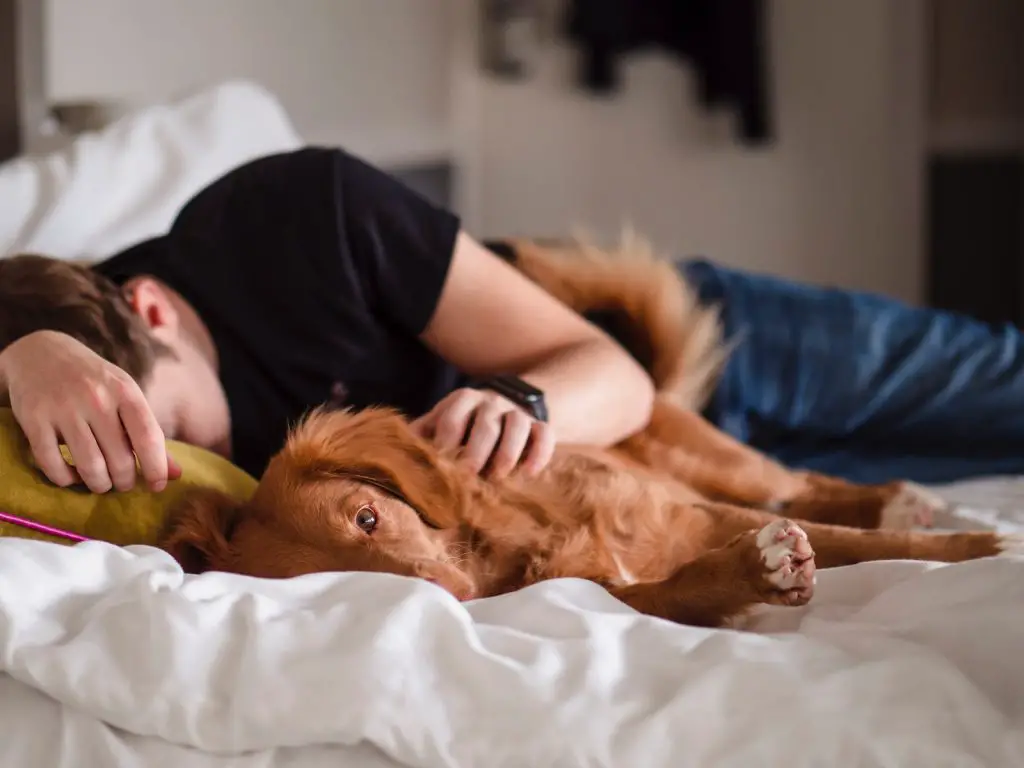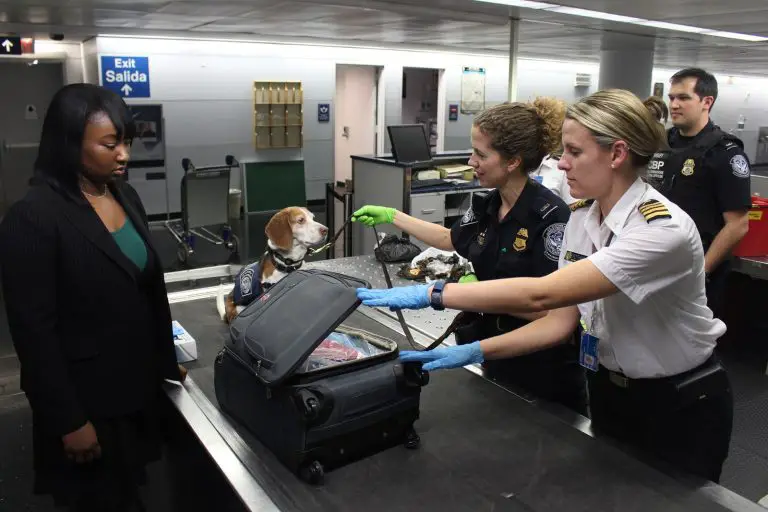Is your pup restless at night not sleeping? Are you wondering how to make a dog go to sleep instantly?
The many struggles of human life keep us awake at night. But, have you ever wondered, why on Earth, your dog, who is leading a cheerful, happy life, is unable to fall asleep?
If you are winding up the day for a good night’s sleep and your dog looks restless or doesn’t look as if it is ready to relax, there may be a reason.
On average, an adult dog sleeps 12-14 hours a day, and it extends to 15-17 hours if it is a pup. Sleeplessness in your Fido can occur when its daily routine has been disrupted. It can lead to your dog showing signs of anxiety.
Well, the good thing is, this type of behavior in dogs is only temporary and will wade off if provided with proper care. Instead of worrying about it, you need to study the causes and treatments.
Don’t worry; I can help you with that!
I have created this how to make a dog sleep instantly guide out of the experience. I hope you will find it helpful

How to Make a Dog Fall Asleep Instantly?
Social, mental, and physical problems of dogs distract their sleeping patterns. Here are some ways to help your dog to cuddle in and sleep through the night.
Method A: Get Your Dog to Be Active
Here are three ways to add more activity to your dog’s daily routine.
Tire Your Dog by Exercising
As a dog owner, you probably know that dogs have plenty of extra energy, which they need to release. Hence, you must take your dog out to exercise and explore. Daily exercise not only helps your dog attain proper sleep but also is vital for its overall health. Ensure that your dog gets plenty of regular exercise.
Give Toys to Your Dog for Playing
Invest in quality chew toys. When you are not around, the toys will keep them busy. Licking and chewing can be very soothing and relaxing for dogs. The feeling of utter exhaustion will make them want to sleep.
Take Your Dog for a Long Walk
Daily 15 minutes (minimum) of walk in the morning and 15 minutes in the evening is a must for dogs. Make sure that you plan your schedule accordingly.
Method B: Feed Your Dog Proper Diet
Avoid Foods That Make Dog Highly Energetic
Give your dog foods that are natural without any additives. There are dog foods in the market that tend to make dogs highly energetic. You need to avoid such foods for your dog if your dog is already active and curious about things. These foods can make them hyper excited, which is something that you don’t want.
Proper Feeding Schedule
You need to establish an appropriate feeding schedule. I recommend having two meals in a day for dogs – Breakfast and Dinner. Don’t overfeed your dog. It can cause severe obesity.
Bribe Dog with Calming Treats
In between breakfast and dinner, you can allow your dog to munch on calming treats. Talk to your dog’s vet about the products available that can help calm your dog.
Method C: Train Your Dog to Relax
Make Sure He Has Relieved Itself (Poop and Pee)
When you take your dog out, it is not only to give them proper exercise but also to ensure that they keep themselves relieved. In some cases, dogs get distracted by the sounds and sights of the world that they are unable to do their business. So, you need to ensure that your dog has relieved itself.
Make Dog Bed Comfortable
A dog will sleep contentedly if its bed is comfortable from everywhere. From soft blankets to the right temperature, and proper coverage, you need to consider everything to ensure that your dog sleeps comfortably. If your dog sleeps in its crate, ensure that there is adequate ventilation. You can invest in a quality dog bed with all the necessary features.
Establish a Nighttime Routine
Lastly, you need to establish a nighttime sleeping routine for your dog. You need to teach your dog that after dinner, it is its sleep time. Feed your dog dinner; let it relax a bit before you take it for a walk and one last bathroom leak.
Method D: Provide Quiet Sleeping Space
Put a Ticking Clock Next to the Dog (Hypnotize)
Just like music acts as therapy to us, it can be for dogs as well. A ticking clock will also do the trick, especially for puppies and young dogs, since it mimics the mum’s heartbeat. You can also play a lullaby.
Eliminate Noises or Distractions (Loud Music)
Avoid loud music and eliminate distractions. If you are watching TV or listening to music while working, keep the volume down or let your dog sleep in another room. I recommend training your dog to sleep alone or inside its crate.
Eliminate Separation Anxiety (Don’t Let the Dog Share a Bed with You)
Never allow your dog to share a bed with you, especially during nights. It can cause separation anxiety since your dog will be spending at least 8 hours with you.
Method E: If Necessary, Use Sleeping Aids
Use Calming Music to Soothe Dog to Sleep
Music can play therapy for your anxious dog. Anything smooth and calming can help your dog relieve stress. You can prefer meditation music. Moreover, there are albums specially dedicated to dogs. You can look for them.
Use Essential Oil to Calm Dog
Sleeping aids such as essential oils and medications can help your dog achieve proper sleep. Essential oils like lavender oil and cedarwood oil are known for their relaxing and calming effect on dogs. You can spread a few drops of essential oil around its bed or crate.
Give Dog Sleeping Aids
Moreover, you can give your dog sleeping aids such as Comfort Zone Adaptil (pheromone), Melatonin, Benadryl, and Homeopathic treatment (calming drops). You can mix a few drops of the solution in your dog’s water bowl.

Why Can’t Your Dog Fall Asleep Instantly?
There may be several reasons why your dog isn’t able to sleep. It can be frustrating for you and the dog both. But if you can determine the causes, you might be able to help your dog lower down the restlessness.
However, it can be challenging to identify the reason behind your dog’s restlessness since it doesn’t have all the strains and stresses of daily life. But if you think something is wrong, you can start by looking for the following signs:
- Pacing late at night
- Barking
- Constant Whining
The following could be the reasons why your dog can’t fall asleep instantly:
Physical Pain
Just like human beings, restlessness in dogs occurs when it is experiencing some physical pain, and there aren’t any distractions to keep their mind off the issue. It can come from several different things, including:
- Arthritis
- Bug bites
- Itchy skin
- Hot spots
- Cancer
If your dog is in pain or has uneasiness, it might lick a specific part of its body frequently. Your dog might be having an issue around a joint, or maybe a cut or scratch. Further, your dog might have skin irritation or a rash that they need you to notice.
On the other hand, if your dog is continuously smacking its lips or drooling excessively, it is a sign that your dog is having an issue with digestion. They may also go out for toilet breaks more often than usual. Frequent toilet breaks are typically signs of a disease, some kidney or bladder infection.
Well, as a dog owner, you don’t want your dog to be uncomfortable at all. They can’t tell you what’s wrong with them, but they will display you all sorts of signs. If your dog is showing such symptoms, you are advised to take it to a vet immediately. A vet can help diagnose the condition your dog is suffering from and provide the right treatment.
Emotional Buildup or Anxiety
Of all the animals, dogs are probably the most sensitive ones. Consider this; only having people visiting your home can be quite overwhelming for your dog. The dog might not show it much, but they become startled. First-hand sounds, new sights, and a range of fresh scents for them to encounter, it can be overwhelming for any dog.
New experiences not only breaks their routine but can also make them feel anxious but can inadvertently leave dogs unable to relax. Hence, they won’t be able to sleep properly.
Other causes of emotional buildup could be when they encounter loud noises like thunderstorms or during New Year’s Eve when there is plenty of fireworks. Dogs can sense fear, and hence, they release a natural hormone that puts them at an amplified level of vigilance.
So, you need to premeditate everything early. If you have visitors coming over, put your dog in its crate, and slowly introduce it to them. If there’s thunderstorm or fireworks, try to divert your dog’s mind. Help your dog stay calm in all situations. Throw them a chew toy, lure them with food, or play with them.
Excessive Energy
If your dog is all alone at home while you are at work, it will be tremendously hyperactive when you come home. Not only your dog is super excited to see you after so many hours, but it has also accumulated pent-up energy throughout the day from lying and sitting around waiting for some stimulation.
Dogs need to work off their energy; else they can become super-hyper. Being hyper can make them restless and sleep-deprived. Moreover, they may engage in destroying things at your home, biting off the curtains, scratching the floor, and ripping off the cushions, among others. They need a release of energy and mental stimulation. Exercising your dog will help them feel worked out.
You can play fetch with your dog, or take it for a walk or run in the park daily. If you aren’t able to do this, you can tell someone from your family to look after it or hire a dog-walker for the same.
At least 15 minutes of daily walk is necessary for dogs. You can do it twice a day. Moreover, when you are leaving for work, you can leave some chew toys for your dog in its crate. It will help your dog provide mental stimulation and some workout while you are away.
Loneliness
If you just bought a new pup to the home, the chances are it will take some time to adjust to its new surroundings. So, your new dog might not fall asleep peacefully for the first couple of days. Perhaps, your dog doesn’t know how to be on its own. It misses being with its mother or around other dogs.
So, your dog will need time to settle in its new home, with its new family. If your dog is feeling lonely, it will express it through lots of scratching, whining, and barking at whatever it is inhibiting it from getting to you. It can be a door, a wall, or anything else in your house.
If it is just a pup, I recommend that you put a ticking clock in the room where your dog spends most of its day. The ticking will mimic the mother’s heartbeat. Hence, it will keep your dog content.
Is Your Dog Suffering from a Sleeping Disorder?
Don’t be surprised when I say sleeping disorder in dogs. Not only humans but dogs too can suffer from sleeping disorders. Our canine friends need proper sleep to go about their daily activities with full energy.
Sleep-deprivation in dogs can cause harm to their immune system, affecting their behavior as well. Dogs with sleeping disorders might cry, whine, or frequently wake up from sleep, becoming more sluggish during the day.
In dogs, sleep deprivation can lead to the buildup of stress hormones, which can make them more aggressive as well. Thus, you need to identify the symptoms of a sleep problem in your dog so that you can help your dog start feeling better.
The following are the signs that indicate your dog is suffering from a sleeping disorder.
Loud Snoring
Most of the dog owners think that their Fido snoring is the cutest thing ever witnessed. As cute as it sounds, it might be a sign of sleep apnea. Although not all the cases of snoring relate to sleep apnea, it is still worth examining. If your dog’s snoring is frequent and loud, you may want to consult it with the vet.
Gasping for breath in between snores solidifies the fact that your dog has sleep apnea. You need to get your dog to the vet as soon as possible as this condition can be dangerous. Loud snoring is the most common condition in flat-faced dogs.
Chasing Squirrels in Its Sleep
If your dog always seems to be doing physical activity during sleep, this is an indication that your dog is suffering from a sleep disorder known as REM Behavior Disorder. In this condition, the dog is always moving in its sleep. If the condition worsens, there have been cases of dogs becoming extremely violent like attacking nonliving objects or running into walls.
If you see your dog doing any physical activity in its sleep, there is nothing you can do but seek a vet’s help. The vet can provide your dog with medications that can help your dog rest easier.
Insomnia
If you think that your dog isn’t getting enough sleep, it could be a sign of insomnia. Although it is rare to see a dog suffering from insomnia, anxiety, stress, underlying medical conditions, and lack of physical activity are all things that keep dogs from getting proper sleep. Insomnia is more common in older dogs, and it is usually a sign of the medical condition.
Sudden Collapse After Activity
If you see your dog passing out after a gush of physical activity, this may indicate that your dog has narcolepsy. It is a genetic condition in dogs most common in breeds like Labrador retrievers, poodles, and Doberman pinchers.
In this condition, a dog will suddenly collapse after physical activity and fall asleep. Sudden collapse usually happens after physical activity or period of excitement, such as greeting family members, playing, eating, and more.
According to dog specialists, in narcolepsy, the muscles become slack, and the dog goes into a deep sleep with rapid eye movement.
Petting, loud noise, and other kinds of external stimulation will abruptly wake up the dog. The condition can be treated using lifestyle changes and is not considered harmful.
At least 15 minutes of daily walk is necessary for dogs. You can do it twice a day. Moreover, when you are leaving for work, you can leave some chew toys for your dog in its crate. It will help your dog provide mental stimulation and some workout while you are away.
Pacing at Night
Your dog may be suffering from dementia, if it is older, cries, and walks at night. Although it is technically not a sleeping disorder, dementia can negatively affect sleep. It can be only managed through proper medical diagnosis and intervention.
If your dog has a sleep disorder, it is better if you make an appointment with the vet. However, identifying the signs and symptoms is critical. So, you need to keep an eye on your dog and check its activities.
Why Is It Important to Understand a Dog’s Sleeping Cycle?
Dogs follow a polyphasic sleeping cycle; that is, dogs sleep multiple times in a day. 12-14 hours of daily sleep is a must for dogs, and if your dog isn’t getting that quota of sleep, you need to consider what’s wrong. Allow your dog to take multiple naps in the day time and at least 8 hours of sleep at night.
Although you cannot control your dog’s sleeping cycle, you can take specific measures like eliminate distractions, keeping your dog well-groomed, and disease-free, among other aspects, to ensure that your dog gets proper sleep.
Get to Know How to Make a Dog Go to Sleep Instantly
That’s it. My guide on how to make a dog go to sleep instantly. As mentioned in the article, several reasons can keep your dog from getting enough sleep. Sleep-deprived dogs are cranky and aggressive. By providing a proper living environment, healthy food, and regular exercise, you can ensure that your dog leads a healthy and happy life.
If you have any queries regarding the topic discussed above or any other related matter, feel free to ask. I am more than happy to help you.
Daniel Bloom is the mind behind the Dog Pages blog. He created this blog for the love his dog, Augustine. He manages his team of contributors who love dogs as much as he does. When he is not blogging, he spends his time cooking and reading. He never misses his daily walks with his dog and loves to play Frisbee with Augustine whenever he gets a chance.








